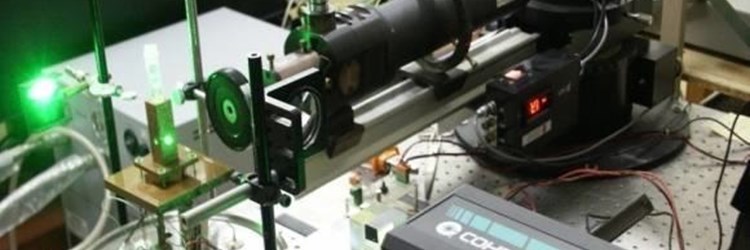

We use Brillouin and Raman micro-spectroscopy to study functions and eventually dysfunctions of biological cells and tissues.
Photon Correlation Spectroscopy (PCS) setup
The photoncorrelation device (Photon correlator Brookhaven BI 9000 AT) consists of a laser source (Coherent: 532nm, 400mW), a goniometer with a special accommodation for samples and a correlator board installed in a computer. The digital correlator works using three sections of channels (low, mid and high speed with different sampling time range) and is able to cover a dynamic range over ten decades (25ns-1310s).
Instrumentation:
μBLS-μRAMAN
We developed a new instrument for simultaneous Brillouin and Raman measurements with sub-micrometric spatial resolution. It operates over an exceptionally wide spectral range, with the high contrast and high resolution unapproachable by ordinary devices. We expect that it will move the frontiers of joint Brillouin-Raman spectroscopy forward by enabling applications in nontransparent media from photonic materials to biomedical applications. It holds promise not just for fundamental research but also for medical diagnosis.
PCS
We assembled a photon correlation Brookhaven BI 9000 AT set up consisting of a laser source (VERDI 532nm, 200mW), a goniometer with a special accommodation for samples and a correlator board installed in a computer. The digital correlator works using three sections of channels (low, mid and high speed with different sampling time range) and is able to cover a dynamic range over ten decades (25ns-1310s). The apparatus consents to calculate, in the time domain, the autocorrelation functions of the intensity of the electric field scattered by the selected sample. The spectra can be recorded using either a fixed geometry or varying the scattering angle, thus allowing access to several exchanged vectors (q=0.01-0.035nm-1).
CD
A JASCO J-810 spectropolarimeter for circular dichroism measurements has been equipped with cells from 2 mm to 10 mm to measure the secondary structures of proteins (from fractions to hundreds of mg/ml) and DNA sequences (micro to milli molar) over broad concentration ranges. Statistical singular value decomposition algorithms have been developed for the deconvolution of principal spectral components.
Based on the interaction between light and matter, spectroscopic techniques are able to study molecular composition and vibrational dynamics of matter in contactless configuration and in non invasive way ensuring important applications in biological and biomedical field.
We use Brillouin and Raman micro-spectroscopy to correlate the local mechanical and the chemical properties of the materials. The approach is particularly relevant also for the study of functions and eventually dysfunctions of biological cells and tissues.
We also use circular dichroism in combination with ultra-violet resonance Raman spectroscopy (UVRR) and small angle (SAS) X-ray and neutron techniques to study the interaction between DNA nano-sequences and anticancer ligands. This multi-messenger approach represents a step forward towards the development of biophysical methods to be used in the biomedical field.